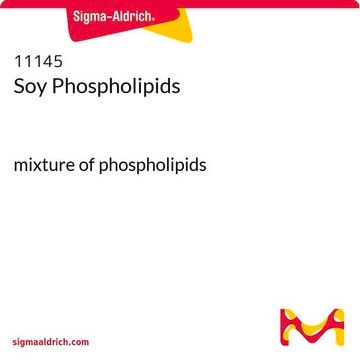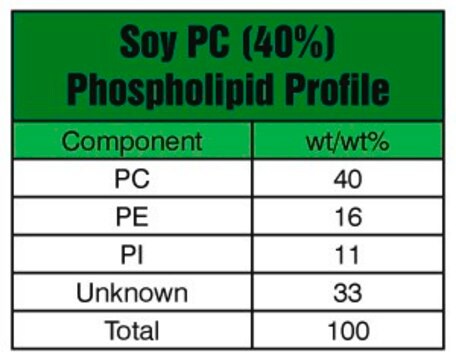Products may be shipped at a different temperature than the recommended long-term storage temperature. If the product quality is sensitive to short-term exposure to conditions other than the recommended long-term storage, it will be shipped on wet or dry-ice. If the product quality is NOT affected by short-term exposure to conditions other than the recommended long-term storage, it will be shipped at ambient temperature. As shipping routes are configured for minimum transit times, shipping at ambient temperature helps control shipping costs for our customers. For more information, please refer to the Storage and Transport Conditions document: https://www.sigmaaldrich.com/deepweb/assets/sigmaaldrich/marketing/global/documents/316/622/storage-transport-conditions-mk.pdf
P5638
L-α-Phosphatidylcholine
from soybean, Type II-S, 14-29% choline basis
Synonym(s):
1,2-Diacyl-sn-glycero-3-phosphocholine, 3-sn-Phosphatidylcholine, L-α-Lecithin, Azolectin, PC
Select a Size
Select a Size
About This Item
Recommended Products
biological source
soybean
Quality Level
type
Type II-S
form
powder or solid
concentration
14-29% (choline)
functional group
phospholipid
lipid type
phosphoglycerides
shipped in
ambient
storage temp.
2-8°C
SMILES string
[P](=O)([O-])(OC[C@H](OC(=O)CCCCCCC\C=C/C\C=C/CCCCC)COC(=O)CCCCCCCCCCCCCCC)OCC[N+](C)(C)C
InChI
1S/C42H80NO8P/c1-6-8-10-12-14-16-18-20-21-23-25-27-29-31-33-35-42(45)51-40(39-50-52(46,47)49-37-36-43(3,4)5)38-48-41(44)34-32-30-28-26-24-22-19-17-15-13-11-9-7-2/h14,16,20-21,40H,6-13,15,17-19,22-39H2,1-5H3/b16-14-,21-20-/t40-/m1/s1
InChI key
JLPULHDHAOZNQI-ZTIMHPMXSA-N
Looking for similar products? Visit Product Comparison Guide
Related Categories
General description
Typical lots of purified soybean phosphatidylcholine have fatty acid contents of approximately 13% C16:0 (palmitic), 4% C18:0 (stearic), 10% C18:1(oleic), 64% C18:2 (linoleic), and 6% 18:3 (linolenic) with other fatty acids being minor contributors. This would calculate to an average molecular weight of approximately 776.
Purified phosphatidylcholine is soluble in chloroform and ethanol.
Other major phospholipid components include phosphatidylethanolamine and inositol phosphatides. Other phospholipids and neutral lipids such as triglycerides, tocopherols, and sterols may be present. Carbohydrates may also be present.
A procedure for determination of the amount of oxidation of egg phosphatidylcholine in a liposome preparation by measurement of the oxidation index has been published.[1] The oxidation index is the ratio of the absorbance at 233 nm to the absorbance at 215 nm. The latter wavelength was chosen since there is little contribution of the fatty acid carbonyl to the absorbance at this wavelength, allowing Beer′s Law to be followed.
A method of determining choline content has been published.[2]
Biochem/physiol Actions
Phosphatidylcholine is used for preparation of vesicle suspensions, commonly called liposomes, or as monolayers.[4][5] Monolayers have been formed using a solution of 1% soybean phosphatidylcholine in hexane.[6]
Valinomycin-induced changes in membrane potentials of red blood cell and phospholipid (phosphatidylcholine from egg yolk plus cholesterol) vesicle suspensions have been measured using positively-charged, cyanine dyes that fluorimetrically responded to the change in potential.[7]
Purified rhodopsin has been incorporated into soybean phosphatidylcholine vesicles.[8]
Quality
Storage Class Code
11 - Combustible Solids
WGK
WGK 1
Flash Point(F)
Not applicable
Flash Point(C)
Not applicable
Personal Protective Equipment
Choose from one of the most recent versions:
Certificates of Analysis (COA)
Don't see the Right Version?
If you require a particular version, you can look up a specific certificate by the Lot or Batch number.
Already Own This Product?
Find documentation for the products that you have recently purchased in the Document Library.
Customers Also Viewed
-
How is shipping temperature determined? And how is it related to the product storage temperature?
1 answer-
Helpful?
-
-
How can I determine the shelf life / expiration / retest date of this product?
1 answer-
If this product has an expiration or retest date, it will be shown on the Certificate of Analysis (COA, CofA). If there is no retest or expiration date listed on the product's COA, we do not have suitable stability data to determine a shelf life. For these products, the only date on the COA will be the release date; a retest, expiration, or use-by-date will not be displayed.
For all products, we recommend handling per defined conditions as printed in our product literature and website product descriptions. We recommend that products should be routinely inspected by customers to ensure they perform as expected.
For products without retest or expiration dates, our standard warranty of 1 year from the date of shipment is applicable.
For more information, please refer to the Product Dating Information document: https://www.sigmaaldrich.com/deepweb/assets/sigmaaldrich/marketing/global/documents/449/386/product-dating-information-mk.pdfHelpful?
-
Active Filters
Our team of scientists has experience in all areas of research including Life Science, Material Science, Chemical Synthesis, Chromatography, Analytical and many others.
Contact Technical Service








